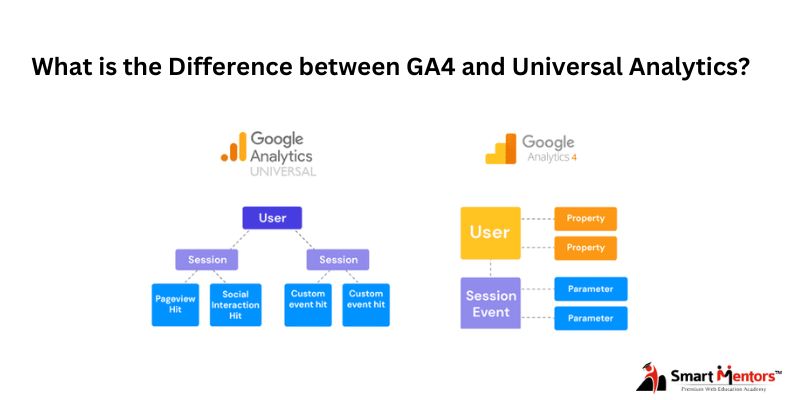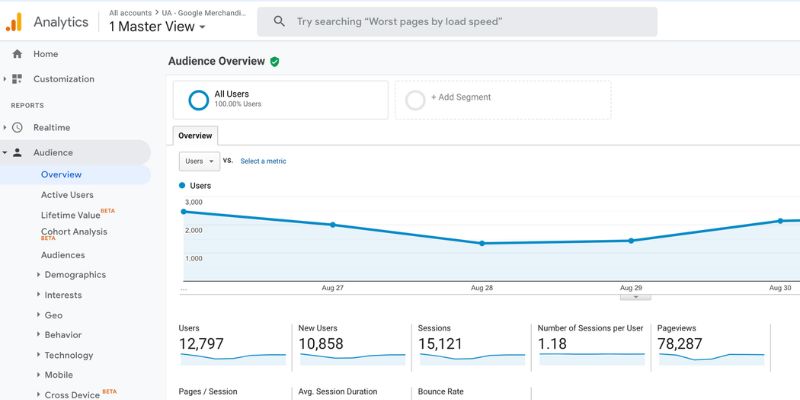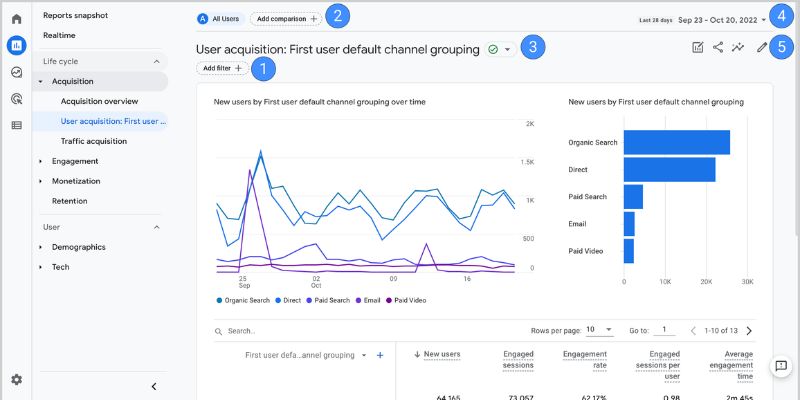What is the Difference between GA4 and Universal Analytics?

Universal Analytics will soon be replaced by the latest version of Google Analytics, GA4. There are more features in the latest version that include new tracking systems, metrics, and reports. These features and more are the difference between GA4 and Universal Analytics.
What is Google Analytics?

Google Analytics 4 (GA4) is the most recent version of Google’s well-known analytics platform 4. It is intended to monitor both your WordPress application and website on the same network. Previously in Universal Analytics, you would have to track your websites and apps separately.
However, GA4 helps you see your customer’s journey more clearly across various channels. With it, users get better data privacy.
What is Universal Analytics?

Universal Analytics (UA) is the previous or old version of GA4. Introduced in 2012, it is perhaps the version many different websites use to track traffic on their website. However, it will soon be replaced by GA4 in the coming months.
As a result, it won’t track your visitors after it is replaced, and Google won’t support it or add new features. Therefore, you must switch to GA4 sooner rather than later. By doing this, you’ll safeguard your data and have access to older records for comparison purposes when UA shuts down.
What Is the Difference Between GA4 And Universal Analytics?
The features of GA4 are expected to be better than its previous version. For this reason, there will be obvious differences between GA4 and UA. Here are the significant differences between both:
1. Reporting interface
The new reporting interface is the first difference you will notice between GA4 and UA. Most of the reports in GA4 have been renamed or replaced. The most recent analytics version makes use of a different measurement model from UA.
For instance, you will see reports like Retention, Monetization, and Engagement in GA4. In contrast, the reporting interface for UA is completely different.
The reports for GA4, for example, are categorized under Realtime, Audience, Behavior, Acquisition, and Conversions. These reports are placed on the left-hand menu on the main dashboard of GA4.
2. New data measurement
How GA4 and UA go about gathering and analyzing the data from your website is another significant difference between them. Your data is tracked by GA4 using an event-based model. The measurement model used by UA is based on pageviews and sessions.
Individuals can be specifically tracked as they engage with your website thanks to sessions, which link data to one person. Event data is untraceable, and emphasis is placed on particular actions taken rather than on particular users who performed those actions. This enables accurate tracking of intricate buyer journeys across various devices.
Additionally, GA4’s enhanced measurement features are now simpler to enable. For instance, it allows you to easily configure scroll depth tracking and outbound link clicks. On the other hand, with UA, you’d need to go through a laborious setup process or modify the tracking code to set up that kind of link scroll-tracking or click-tracking.
3. No bounce rate and new reporting metrics
You’ll notice right away that GA4 doesn’t have a bounce rate metric. With GA4, you also get new reports and metrics. The number of visitors who left your website without taking any action such as clicking a link, subscribing to a newsletter, or making a purchase, is known as the bounce rate.
Instead, the new metric “Engaged sessions per user” is displayed in GA4. It shows the number of interactions your content has received. This includes sessions where a user views two or more pages, engages in one or more events, or stays on a page for at least ten seconds.
In addition to that, the engagement report for GA4 also includes more new metrics. For instance, there is a metric called average engagement time, which in UA was known as average session duration. Screen and pages are yet another brand-new metric in GA4. It displays the portions of your app and pages that generate the most traffic.
4. Form conversion is not tracked by GA4
The form conversion is another one of the differences you will notice between GA4 and UA. Any business can benefit greatly from using forms. They give users a way to contact you, give feedback, and ask questions. You can see your WordPress form that performs better when you track it on GA4.
However, you will need to add a custom code so you can set up your form conversion tracking in GA4. This can be challenging if you are not a developer. The smallest error can ruin your tracking and crash your website.
5. Events now replace UA goals
Goals are used to record different user interactions in UA. There are 4 different types of goals at UA which are:
- Destination: By setting a destination goal, you can keep track of when a user reaches a particular page, such as a product landing page or a thank-you page.
- Duration: You can use this goal to see how long visitors stay on your website before leaving.
- Pages per visit: By using this goal, you can know the number of pages a visitor views before leaving your website.
- Event: You can track user actions that UA does not automatically track on your website using events.
However, these four goals are replaced by GA4.
6. Advanced analysis is performed in GA4
The level of sophisticated analysis that GA4 allows you to conduct is another difference between it and UA. Custom reports can be made in UA, and secondary dimensions can be used to find insights. GA4 goes a step further, though, with its Exploration reports.
You can create custom reports or use prebuilt templates for the various analyses you’d like to run. You can, for instance, use the “Funnel” exploration template to observe the path your customers take before making a purchase.
Conclusion
Many things have changed since Google Analytics switched to an event-based model from a session-based one. Additionally, adjustments will continue to be made because GA4 is still formally in transition. Nevertheless, the features and expected capabilities of GA4 are more sophisticated than that of UA.







No comments, be the first one to comment !